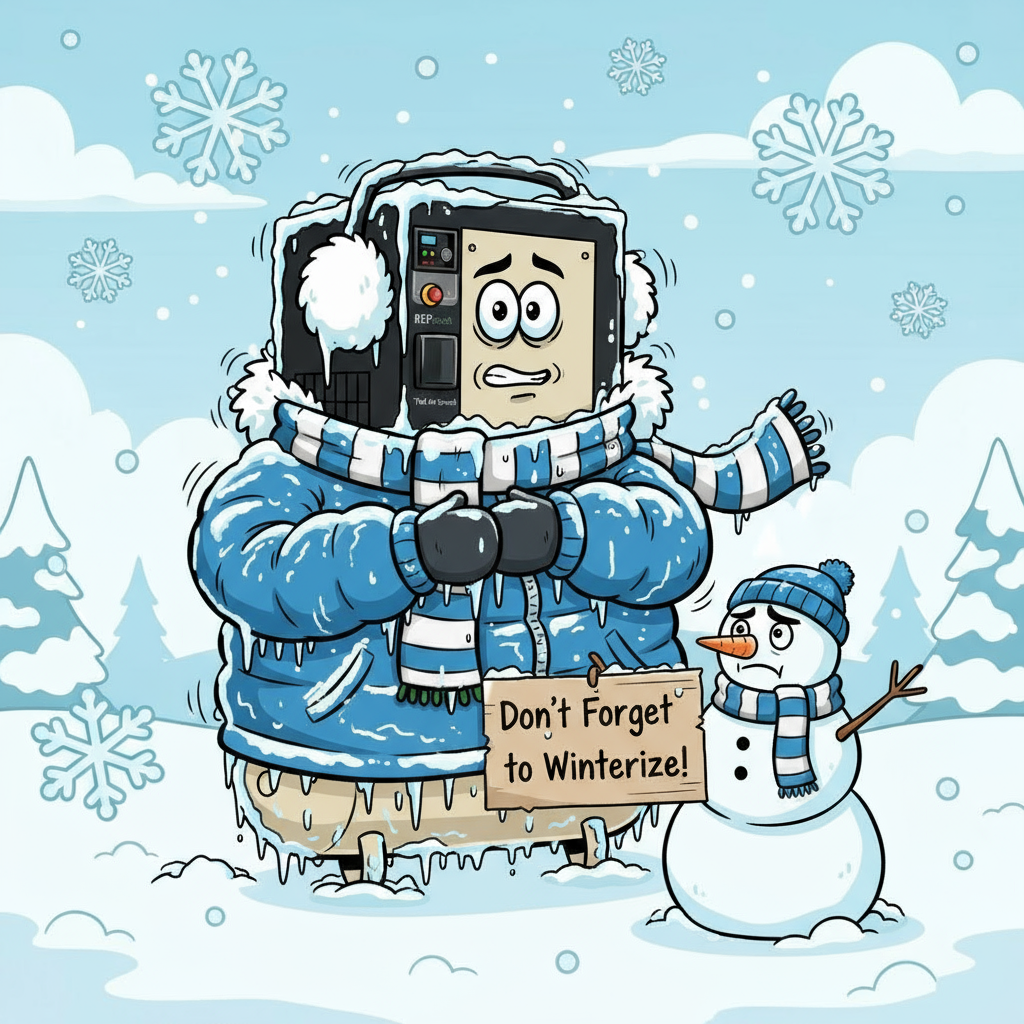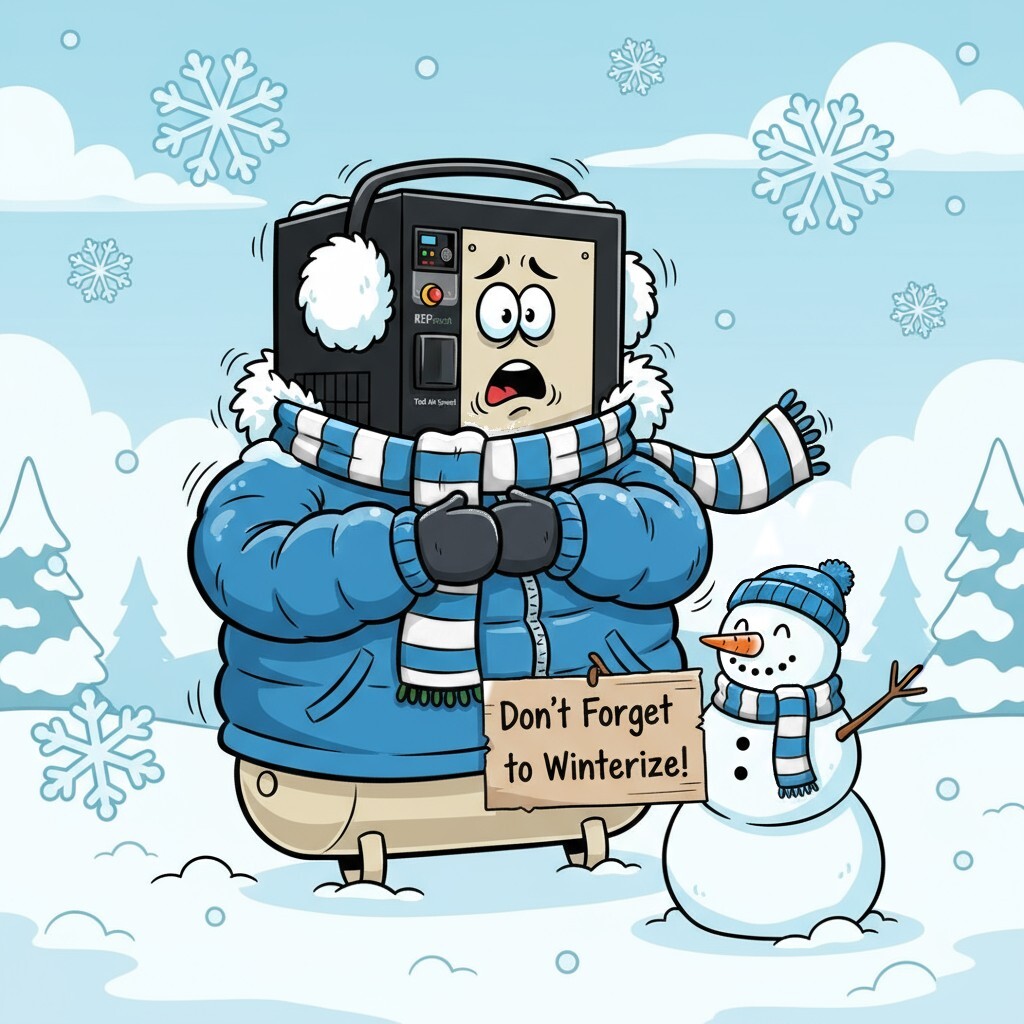Cold-Weather Prep for Compressed Air Systems
Posted by IAP on 10/21/2025

As temperatures drop, industrial air compressor systems face a unique set of risks that can lead to costly downtime if not properly addressed. Cold weather doesn't just make the air crisper, it thickens lubricants, freezes moisture in vulnerable areas, stresses seals and fittings, and puts serious strain on components during startup.
A compressor that ran perfectly in summer may suddenly fail to start on a frigid Monday morning. Because the oil is too viscous, the drain valve froze, or condensation expanded and cracked a line. And when that happens, you’re not just dealing with downtime. You’re looking at repair costs, safety risks, and lost production that could’ve been avoided with a few simple steps.
This Guide Will Walk You Through
- Proactive winter maintenance routines that protect your equipment
- Must-have cold weather accessories and parts to stock up on
- Checklist-style action items for winterizing your air system
By the end, you’ll have everything you need to prep your compressors for sub-zero success, without scrambling in January.
Relevant Resources
→ Air Compressor Maintenance Pillar Blog
→ Shop All Air Compressor Parts
Recommended Products to Have on Hand
→ Ultimate 8000 Synthetic Oil (Cold-resistant synthetic for rotary screw units)
→ EDV-500 Electronic Drain Valve (Prevents freezing from manual valve backups)
→ Air Intake Filters (Ensure clean, dry air in colder climates)
Drainage & Moisture: Your #1 Freeze Risk
Of all the winter-related failures that affect industrial air compressors, moisture freezing is the most common, and the most destructive. If water is allowed to accumulate in your tank, filters, or lines, it can freeze solid in cold conditions, expanding with enough force to crack fittings, rupture drain valves, or damage receiver tanks.
The problem starts with condensate, which forms naturally as compressed air cools. In warmer months, you might get away with a little buildup, but when temperatures drop below freezing, any trapped moisture becomes an ice plug waiting to cause problems.
Key Areas Where Moisture Freezes First
- Tank bottom (manual drain often neglected)
- Inline filters and oil separators
- Low points in piping systems
- Manual drain valves (prone to cracking if frozen shut)
Solutions to Stay Ahead of Freeze Damage
- Fully Drain Tanks and Lines Before Cold Hits
- Make sure tanks and low points are drained completely, especially overnight or on weekends when compressors sit idle.
- Use gravity drain points or switch to automated solutions for peace of mind.
- Upgrade to Electronic Auto Drains
- Manual draining leaves room for error. Auto drains like the EDV-500 Electronic Drain Valve ensure reliable, timed moisture removal even in unmanned shops or after hours.
- Install Inline Water Separators
- Capture water before it makes it to your tools or tanks. The right inline water separator can dramatically reduce downstream freezing and improve air quality.
- Replace or Maintain Drain Kits and Valves
- Older valves can stick or clog, especially in cold weather. Consider a receiver tank drain kit to streamline replacement and prevent surprises.
Oil Health in Cold Temperatures
Just like in your car, cold weather has a direct impact on compressor oil, only the stakes in an industrial system are higher. As temperatures drop, oil viscosity increases. That means it becomes thicker and harder to circulate through critical components during startup.
Why This Matters
- Harder starts in rotary screw or piston units
- Reduced lubrication in the airend or pump during warm-up
- Increased mechanical wear, especially in high-speed or continuous-duty compressors
- Risk of oil pressure alarms or shutdowns on systems with tight tolerances
Signs Your Oil Isn't Winter-Ready
- Sluggish startup or delayed pressure build
- Higher amp draw or breaker trips on cold mornings
- Excessive heat after short runtime (from oil not circulating fast enough)
- Foaming, discoloration, or sludge inside the sump
What You Can Do
- Switch to a Full Synthetic Oil
Mineral oils struggle in winter, especially below 40°F. We recommend switching to a cold-tolerant synthetic like Ultimate 8000 Synthetic Oil. It’s engineered for rotary screw compressors and outperforms OEM-branded synthetics at a better value. - Check for Oil Heaters on Rotary Screw Units
Many IR and Quincy rotary systems include an oil sump heater or airend heater. These must be checked before winter to ensure they're working properly. If you need help sourcing oil heater accessories, IAP can assist. - Top Off or Replace Early
Low or degraded oil compounds winter strain. Always verify oil levels and condition during your winter maintenance checklist.
Hoses, Fittings & Seals: Watch for Cracks and Leaks
Cold weather does more than thicken oil, it makes plastic and rubber brittle, increasing the chances of unexpected air leaks, pressure drops, or total system failures. If your compressed air system has aging or exposed hoses and fittings, winter is the most likely time for those weak points to give out.
Why Cold Weather Is So Harsh on Components
- Rubber hoses and o-rings stiffen and crack under pressure
- Plastic drain plugs and filter bowls can shatter if moisture freezes inside
- Even metal fittings can loosen due to temperature swings and vibration
What to Inspect and Replace
- Air hoses: Check for stiffness, cracking near couplers, and dry rot
→ Shop Hoses & Fittings - O-rings and gaskets: Replace brittle or flattened seals, especially at tank connections and pressure switches
→ Shop Seal Kits & Gaskets - Drain plugs and filter bowls: Swap plastic parts for cold-rated versions or insulate vulnerable zones
- Outdoor piping: Add heat tape or insulation to exposed lines, especially in rooftop or unconditioned locations
Prevent Hard Starts & Power Supply Strain
When temperatures drop, air compressors don’t just run slower, they strain harder at startup, pulling more current than usual and risking serious electrical damage. Cold starts are one of the leading causes of motor wear, tripped breakers, and blown contactors in industrial air systems.
What Happens During a Cold Start
- Thicker oil = higher load on the motor
- Condensate buildup in valves and cylinders adds resistance
- Low ambient temps reduce battery and capacitor performance
- Result: Overloaded motors, blown fuses, or even failed starters
Winter-Proofing Your Electrical System
- Use Cold-Rated Synthetic Oil
A proper lubricant like Ultimate 8000 Synthetic Oil reduces startup friction and protects your motor from overloads on frigid mornings. - Allow Warm-Up Cycles
Let your unit idle unloaded for a few minutes before pressurizing. This gives oil time to circulate and reduces the initial electrical draw. - Add Motor Heaters or Enclosure Warmers
Keep motors and internal panels above freezing to prevent condensation or stuck components. - Inspect Your Motor Starters and Controls
Winter is the worst time to discover a weak capacitor or bad contactor. Test your starter box and consider stocking replacement kits or contactors to avoid downtime.
Create a Winter-Readiness Checklist
Winter compressor maintenance isn't something you do once and forget. Cold-related failures often come from small oversights, the kind that slip through when there’s no clear system in place.
The solution? A weekly winter checklist tailored to your environment, equipment, and maintenance team.
What to Inspect Weekly in Cold Weather
- Drain tanks and inline separators
- Confirm EDV or auto drain is functioning
- Check compressor oil level and clarity
- Inspect hoses and couplers for signs of brittleness
- Listen for unusual sounds during startup
- Verify operation of oil sump heaters (if installed)
- Check motor starter for heat or residue
- Log run hours for oil and filter planning
Cold-Weather Spare Parts to Keep on Hand
- Ultimate 8000 Synthetic Oil
- Drain Valves and Kits
- O-Rings & Gaskets
- Heater Kits or Contactors
- Air Filters and Separators
Winter Prep Now = Less Downtime Later
Most winter-related air compressor failures (cracked drain valves, frozen lines, hard-starting motors) are 100% preventable with a little preparation and the right parts on hand.
Whether you manage a plant, a shop, or a fleet of field units, taking time now to inspect your system and stock winter-ready components will save you hours of downtime, thousands in repairs, and a lot of headaches when freezing temps hit hard.
Don’t wait until January when parts are on backorder and systems are offline. Stock up early and winter-proof your operation now.
→ Contact IAP for winterization help here or call (414) 422-1717
Your compressors work hard year-round, let’s make sure cold weather doesn’t slow them down.

